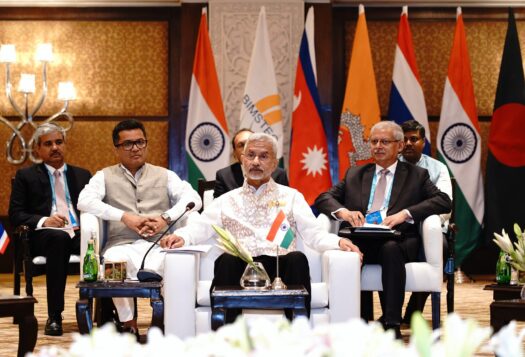
As we enter 2024, economic policy considerations remain at the fore for Pakistan as it faces one of its worst crises in years. Pakistan’s ongoing macroeconomic instability is being fueled by a fiscal imbalance, high dependence on oil imports, and depleting foreign exchange reserves, alongside meeting IMF requirements.
Pakistan’s oil consumption predominantly relates to three sectors: transportation (60 percent), power generation (32 percent), and industry (8 percent). From July 2022 to March 2023, Pakistan’s oil imports stood at USD $13.06 billion. Pakistan’s energy minister recently stated that the country was “heavily reliant” on expensive energy imports and the government had limited control over their pricing.
Policy shifts that improve Pakistan’s nuclear energy generation and electric vehicle (EV) market offer promising opportunities for Islamabad to reduce its dependence on oil imports, a critical driver for macroeconomic challenges. In the long term, such a policy direction can shape new pathways for Pakistan’s sustainable growth.
A Nuclear Energy Resurgence
Policymakers have acknowledged nuclear energy as a promising energy alternative because of the economic impact of climate change and the effect of geopolitical conflicts on the oil market. A 2023 study highlights that the Russia–Ukraine war contributed to a 2.7–4.8 percent increase in global household expenditures, primarily related to rising energy costs. Broadly, fossil fuels contribute 90 percent of global carbon dioxide emissions and result in climatic shocks and global economic challenges.
Recent developments in support of developing alternative energy sources, particularly nuclear energy generation, demonstrate the issue’s growing importance on a global scale. Asia is leading the way with at least 64% of new nuclear power projects. Belgium, Romania, Italy, and the United States have agreed to the joint development of small modular reactors (SMRs) to produce cheap and clean energy.
Policy shifts that improve Pakistan’s nuclear energy generation and electric vehicle (EV) market offer promising opportunities for Islamabad to reduce its dependence on oil imports, a critical driver for macroeconomic challenges.
The United Nations Economic Commission for Europe estimates that nuclear power plants, on average, are among the lowest greenhouse gas emitters. The International Atomic Energy Agency noted that 198 signatory countries “officially called for accelerating the deployment of low-emission technologies, including nuclear energy.” The International Monetary Fund describes these developments as a global “Nuclear Resurgence.” These global developments make clear that Pakistan can move forward with new investments in nuclear power plants (NPPs).
Pakistan is well-equipped to pursue alternative energy sources, as it has over fifty years of power generation experience through nuclear energy. Its six nuclear power plants collectively produce 3,500 MW of electricity, which is a 12 percent share of Pakistan’s total power generation. Thermal fossil fuels (oil, gas, coal, and others), however, constitute 61 percent of Pakistan’s power generation.
The overall market structure of Pakistan’s energy sector has significantly evolved and provides new investment opportunities in clean energy. This is evident with policies such as the National Power Policy 2013, the Power Generation Policy 2015, the Alternative and Renewable Energy Policy 2019, and the National Electricity Policy 2021. These policies offer a road map for investments in clean energy, aiming to reduce dependence on imported fuels and encourage public-private partnerships (PPP).
Pakistan’s EV Policy: Challenges and Potential
Today, 60 percent of global oil demand comes from transportation. Energy experts estimate that global emissions from transport are likely to grow from 25 percent in 2023 to 30 percent in 2030. Such concerns have shaped a broad consensus about EV adoption as the future of transportation. The World Resources Institute stresses that the global percentage of EVs on the road needs to be between 75 and 95 percent by 2030 to stay in line with the global warming target of 1.5°C.

Pakistan’s EV policy is an ambitious plan as it targets an EV market share of 30 percent by 2030 and 90 percent by 2040 in total vehicle sales. The government offers lucrative investment opportunities for manufacturers, assemblers, and suppliers. For instance, the general sales tax for EVs is set at 1 percent, whereas it is 17 percent for regular vehicles. Import duty for charging equipment is set at 1 percent, and lower rates of electricity are proposed for charging stations. The State Bank of Pakistan provides a lower financing rate for EV manufacturers.
Major auto manufacturers are aiming to invest in Pakistan’s EV market as well as sell manufactured units. According to reports, at least six Pakistani companies are manufacturing or assembling electric motorbikes, while licenses have been issued to 31 other companies. MG has also introduced EV models in Pakistan. China’s BYD has demonstrated “keen interest” in Pakistan’s electric vehicle sector, while Xinjian Jingyi announced that it would establish an EV plant and showrooms in Pakistan. Investors in Pakistan’s EV sector can greatly benefit from setting up manufacturing units in Special Economic Zones with attractive tax and import policies alongside cheap labor.
By developing new NPPs, Pakistan can significantly improve its power generation capacity for clean energy, which is integral to EV charging infrastructure and investment in the sector. Prospective auto investors are facing specific challenges while navigating Pakistan’s EV market, such as high inflation and a lack of EV charging infrastructure. Gradually, however, new perceptions about EV/E-Bikes are being shaped. For instance, the Chairman of the Association of Pakistan Motorcycle Assemblers notes that “purchasers of motorcycles are now expressing interest in electric bike… and they express satisfaction as it is saving them up to 15,000 rupees monthly on fuel expenses.” Private investors have long viewed NPPs’ high capital costs and long construction times as barriers to investment. However, NPPs’ low operational costs, which include safety, waste disposal, and decommissioning costs, alongside long-term climate dividends, can help ameliorate such concerns.
A Step Forward: Smart Investment in Pakistan’s EV and Nuclear Energy Sectors
While the benefits of the EV sector are clear, it cannot be considered a green option if the power supply does not come from clean sources. Studies published in journals such as Climate Change, Nuclear Engineering and Design, Energy Research, and Energy offer supporting evidence that nuclear energy is a promising energy alternative for electric and hybrid vehicles.
Policymakers may need to reconsider EV targets if the electric supply to charge EVs continues to be largely generated from fossil fuels. Supplying electricity for EV charging stations from nuclear energy plants could be a step forward in realizing Pakistan’s “Nuclear Energy Visions for 2030 and 2050, to generate 8,800 MW and 42,000 MW, respectively.”
In the long run, a combination of investments in the EV market, NPPs, and other sources of clean energy are likely to help address Pakistan’s macroeconomic issues, meet climate targets, and navigate international pressures.
Pakistan’s historical cooperation with China in the field of nuclear energy holds potential for further investments. In 1986, China signed an agreement to construct C-1, a 325 MW nuclear power plant. This was followed by five additional projects with Chinese cooperation, namely C-2, C-3, C-4, K-1, and K-2. In June 2023 China-Pakistan inked a USD $4.8 billion deal to develop a 1,200-megawatt nuclear power plant known as Chashma 5.
The IAEA notes that with around 20 countries agreeing on increasing nuclear energy capacity three-fold, multilateral development banks and international financial institutions may also consider including nuclear energy in their lending policies. This also offers encouragement for Pakistani policymakers to explore new financing options for NPPs.
The conclusion of COP 28 encouraged global investment in the rapid development of alternative sources of energy. In line with this agreement, Pakistan ought to scale up new nuclear energy projects alongside attracting investment in the EV sector. This by no means implies that other sources of clean energy – such as wind, solar, and hydro – be shelved. Unlike these sources of clean energy, however, fuel supply for nuclear power plants does not depend upon climatic conditions and geopolitical events. In the long run, a combination of investments in the EV market, NPPs, and other sources of clean energy are likely to help address Pakistan’s macroeconomic issues, meet climate targets, and navigate international pressures.
Also Read: Pakistan and the IAEA: A Partnership for Sustainable Agriculture.
***
Image 1: Nuclear Power Plant via Flickr.
Image 2: Electric Vehicle via Wikimedia Commons.


